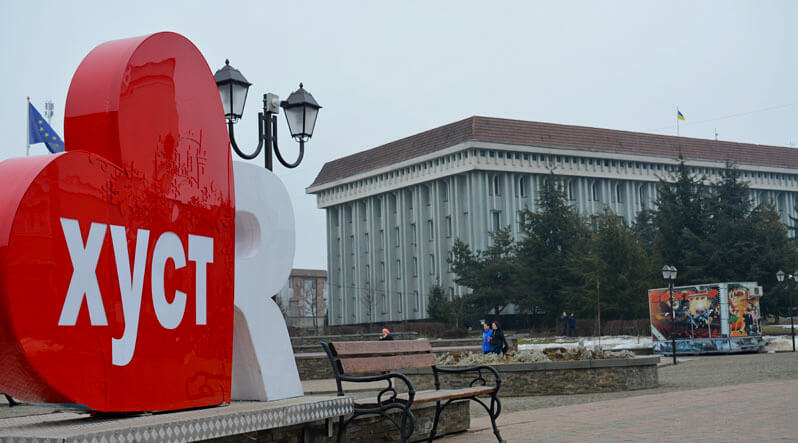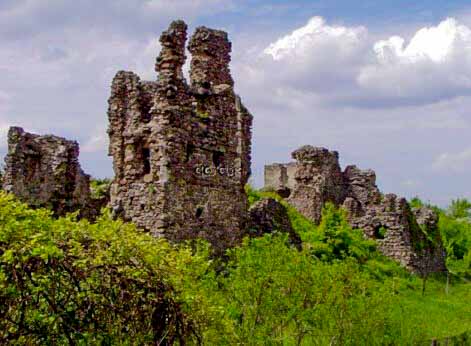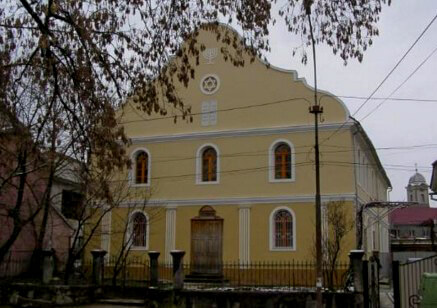Attractions Handkerchief it is worth starting with the Church of St. Elizabeth, which is located at the intersection of Constitution and Carpathian Sich streets. Reformed the Church of the XIII-XIV centuries consists of three parts: an independent tower, a nave and an apse organically United with them. The walls of the temple are decorated gothic windows. During the restoration of 2005 inside the temple found interesting frescos XV century, depicting knights in armor. Similar костел XIII-XIV centuries preserved in the village Vyshkovo Khust district.
From the temple of Elizabeth, you should walk along the street of the Carpathian Sich in the direction of the Roman Catholic Church of St. Anne, which is located at the intersection with the street Over.At the end of the XVIII century for its construction were used building materials from the destroyed by fire Hust castle.

Without changing direction, you should walk a few more meters and turn left and continue walking along Repin street. This is a peculiar passage, on both sides of which there are counters of street vendors, shop Windows of cafes and stores. The variety of colors and the rapid flow of pedestrians create a feeling East. It grows when you go to independence square, which has been turned into A city Bazaar. The Eastern flavor of the market is given by the Golden domes of the Orthodox Church.
Turn left at the square and a few meters later you can see the building the synagogue of the Kabbalists. At the beginning of the XX century, the city was home to a large Jewish community. In the spring of 1944, when the Nazis took Jews to concentration camps, they brought their spiritual literature for storage in the synagogue building. Several hundred Jews who were lucky enough to survive and return home took back their books. After Khrushchev’s “thaw”, emigrating, they and their children again brought the Talmud to the synagogue, where the books are still stored. Khust synagogue impresses with its richness, excellent condition of interior decoration, ornaments and furniture. In Soviet times, the building remained intact. Fortunately, it was never converted into a warehouse or gym in those days. This synagogue is active, it resumed its activity in 2000.
Nearby is the so-called Czech the quarter that was built at the beginning of the XX century by Czech colonists. It consists of elegant houses with roofs covered with red tiles.

Ще коли замок був дерев’яним, його зруйнувало нашестя хана Батия в 1240 р. В 1262 р. – фортецю відбудовано. Тут був центр Угочанської жупи, яка була найменшою за площею в Угорському королівстві.
From the synagogue, the tour should continue in the same direction until the intersection, where you should turn left on Constitution street. At the end of it you can see the already familiar reformed Church. From its walls, you should turn right, cross the road, and then walk along the 900th anniversary of Justa street in the direction of the Castle hill. At the intersection with Pirogov street, you can see the city Council building. It was in this building that the independence of the Carpathian Ukraine was declared in March 1939.
Then you should cross the Khustets river, after which you can start climbing to the left along the paved road through the city cemetery, to the walls of the Khust castle. Enjoying the panorama of the city and the scenery of river valleys River and Yew tree from the observation deck at the top of the mountain, you can go down the same road to the city. The ascent to the Castle hill and descent from it will take no more than an hour. The height difference is about 150 meters. The entire walk around the city will take a maximum of two hours.
Khust photos, Transcarpathia
#отдыхаемнаприроде #замковаягора #хустзамок #закарпатье #замковагора #закарпаття #хуст #хустзакарпаття
Мы переехали с севера Украины в Закарпатье, к нашим детям и внукам, и теперь я хожу гулять в городской парк #немойпрекрасныйсад #хуст #прогулкавпарке #летовгороде #закарпатье #summergarden #khust #rosesingarden #flowers #loverflowers #gardenlove #хустзакарпаття
🤍🤍🤍
.
.
.
#хуст #хустзакарпаття #украина #фото#travel#travelphotography#ukraine#mountain#ukrainiantravelers
Хуст, Закарпаття
Khust, Ukraine
#хустзакарпаття
#хустукраїна
#хустукраїна
#україна
#украина #хуст
#закарпаття
#европа
#мicто
#хустзакарпатье
#закарпатье
#khust
#ukraine
#transcarpathia
#europa
#dzhuhacities
#dzhuhaukraine
#dzhuha_europe
Ми чекаємо вас з 9:00 до 00:00❤️
⠀
Обирайте серед двох затишних терас та приходьте відпочивати з рідними й друзями👨👩👧👦
⠀
Пишіть в коментарі + ті, хто сьогодні точно прийде до нас в гості😜
⠀
📲 +38 (096) 957 49 57
📍м. Хуст, вул. Львівська, 122
Дякуємо, що обираєте Premiere для святкування важливих подій❤️
⠀
На фото чарівна vladka_danilovska_ 😍
⠀
📲 +38 (096) 957 49 57
📍м. Хуст, вул. Львівська, 122
Error: API requests are being delayed. New posts will not be retrieved for at least 5 minutes.








